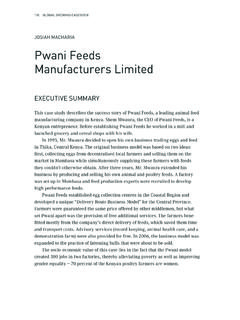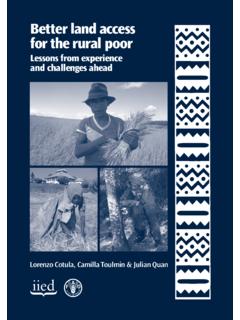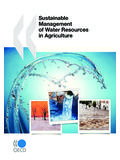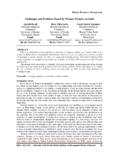Transcription of ATSBAHA GEBRE-SELASSIE, TESSEMA BEKELE A …
1 36 GLOBAL GROWING CASEBOOK. ATSBAHA GEBRE-SELASSIE, TESSEMA BEKELE . a review of ethiopian agriculture : roles , Policy and Small-scale Farming Systems BACKGROUND. agriculture is the backbone of the ethiopian economy. This particular sector determines the growth of all other sectors and consequently, the whole national economy. On average, crop production makes up 60 percent of the sector's outputs, whereas livestock accounts for 27 percent, and other areas contribute 13 percent of the total agricultural value added. The sector is dominated by small-scale farmers who practice rain-fed mixed farming by employing tradition- al technology, adopting a low input and low output production system. The land tilled by the ethiopian small-scale farmer accounts for 95 percent of the total area under agricultural use and these farmers are responsible for more than 90 per- cent of the total agricultural output. Small-scale farmers produce 94 percent of the food crops and 98 percent of the coffee, the latter being Ethiopia's leading export good.
2 Private and state commercial farms produce just 6 percent of food crops and 2 percent of the coffee grown. These commercial farms use about 5 percent of the total cultivated land. Coffee, cotton, tea, fruits, and vegetables are the major crops grown by the few commercialised state farms, although with very minimal return despite huge investments in them (MEDIC 1999). With these statistics, one can easily infer to what extent the small-scale farmers (who are all rural dwellers) are the key element in strengthening the effort towards agricultural growth and consequent- ly to the overall economic growth. The country has varied agro-climatic zones. The Government extension pro- gramme lists these as: areas of adequate rainfall; areas of moisture stress; and pastoral areas. Farmers traditionally classify them as dega (cool), woina dega COUNTRY ANALYSES: ETHIOPIA AND D. R. CONGO 37. (temperate) and qolla (low land; warm climate).
3 This diversity makes it a favoura- ble region for growing a variety of crops (Desalegn Rahmato 2008). The country is endowed with one of the most biodiverse ecosystems in the world. It has earned the name the Water Tower of Eastern Africa for having more than ten rivers, each of which has irrigation potential. It also has the largest livestock population in Africa (est. 114 million), per capita (MEDIC. 1999). As regards to the agricultural suitability of the country's territory, some estimates indicate that more than 65 percent ( million hectares) of the land is fertile for agricultural purposes (Haile Kibret 1998). Demographically, the country is the second most populous country in Africa after Nigeria. In 2007, Ethiopia had a total population of million. The total fertility rate of the country is children per woman; for urban and for rural women (estimates for the years 1995 2000). 83 percent of the population lives in rural areas, whereas only 17 percent reside in urban areas.
4 However, a report by UN-Habitat (Economist 2010) foresees an increase of 62 percent in the number of urban dwellers by the year 2025 for Addis Ababa. The same source also states that the age structure of the population is youth dominated, similar to Ethiopia is known as the Water Tower of Eastern Africa. 38 GLOBAL GROWING CASEBOOK. other developing countries. 43 percent of the total population is under the age of 15. With such a predominantly young population the country has undoubtedly the potential for fast growth (theoretically known as population hidden momentum ). The UN report also indicated that the dependency ratio (the proportion of the population younger than 15 and older than 64 to the total population) is high;. percent of the population is the productive segment and the remaining percent is the dependent segment. From this data, it is possible to infer that such a high dependency ratio can easily hamper the country's efforts to develop.
5 Being aware of the above mentioned factor endowments a huge labour force in the rural areas, relatively abundant agricultural lands, diversi ed agro-climatic zones and suf cient water resources the Government of Ethiopia has devised the current national development strategy called Agricultural Development Led-Industrialisation (ADLI). ADLI takes agriculture as the engine of national economic growth. Through ADLI, the country plans to end up with rapid and sustainable economic growth and independence from foreign food aid, ensuring maximum bene t for the local population in the context of a free, open market. As the Government has taken the small-scale farmer and the local leadership (lower strata of the administration) as active and fundamental players in the implementation process, building the capacities of the peasant farmers and the local leadership are the two most important goals. This paper tries to asses and to identify the role of the agricultural sector in the ethiopian economy at macro- and micro-levels.
6 Eventually, it identi es possible areas within which the voluntary sector could intervene in supporting the sector at both national and local levels. COUNTRY ANALYSES: ETHIOPIA AND D. R. CONGO 39. THE PLACE OF agriculture IN THE ethiopian . ECONOMY: THE MACRO-LEVEL. THE ROLE OF agriculture . In 1999, The Federal Ministry of Economic Development and Cooperation (MEDIC), (now called the Ministry of Finance and Economic Development MoFED), revealed that agriculture contributes greatly in terms of export, employment, and subsistence to the ethiopian economy. It contributes 50 percent of GDP, 85 percent of employment (the rural population of Ethiopia), 90 percent of earnings from export, and 70 percent of raw material requirements for large and medium industries that are agro-processing (MEDIC 1999). Haile Kibret revealed that the agricultural sector, due to its major contribu- tion to the GDP, highly in uences the performances of the other sectors of the economy (Haile Kibret 1998).
7 It, for example, accounts for more than 80 percent of employment and 90 percent of exports. ethiopian export commodities are agricultural outputs: coffee; hides and skins; and seeds and nuts used for edible oil production. As these are the main sources of foreign earnings, they also automatically de ne the country's capacity to import other materials used in manufacturing. Kibret also stresses that macro aggregates, like employment and in ation rates, are also in uenced by the sector (Haile Kibret 1998). Ethiopia's 2004 Millennium Development Goals (MDGs) report jointly compiled by the MoFED and the UN Country Team con rmed these statistics and stated that the ethiopian economy is fundamentally rural and agricultural. Agricultural employees account for more than 85 percent of total population and the sector contributes to half of the GDP. Nonetheless, recent sources indicate that there is a shift in agriculture 's contribution to GDP.
8 The updated estimates of the 2005/06 ethiopian scal year (year 1998 in the ethiopian calender) and the 2006/07 forecast (year 1999) are based on the 1999/2000 base year, which revealed that the GDP contribution (both nominal and real) of agriculture was taking a lion's share of the total GDP growth with percent in 1995/6. This had started to decline, and reached percent in 2002/3. Its contribution then rose again to percent by 2005/6. Table 1 shows the share of agriculture to nominal and real GDP. The same report indicated that the GDP contribution of the major sectors for the year 2005/6 were 47 percent, 13 percent and 40 percent for agriculture , indus- try and services, respectively. The national economy grew at an average rate of 40 GLOBAL GROWING CASEBOOK. percent for the three successive years of 2003/04 to 2005/06. For this period, the agricultural sector contributed 60 percent of the growth whereas the industry and the services sectors contributed 10 percent and 30 percent, respectively (MoFED 2006).
9 One can therefore easily understand how agriculture has been playing the key role in speeding up the overall growth of the economy. In the history of Ethiopia's export markets, coffee has been the number one export good, dominating all other export products. It not only supports the entire economic growth of the nation but it is also the source of income for millions of coffee growers, thousands of coffee traders, primary cooperatives and unions, nancial institutions and transportation enterprises. Some of the ethiopian coffee importers include Germany, Japan, Saudi-Arabia, Belgium, USA, Italy, France, the Sudan, England and Switzerland. Oil crops take second place in terms of ethiopian agricultural exports. Niger (nueg), sesame seeds, sun ower and ground nuts are also exported to Asia, Europe, America and Africa. Countries like China, Turkey, Israel, USA, Jordan, Greece, Switzerland, Yemen, Saudi Arabia, Canada and Britain are the main export partners.
10 SHARE OF agriculture SHARE OF agriculture . YEAR. TO NOMINAL GDP TO REAL GDP. 1995/96 1996/97 1997/98 1998/99 1999/2000 2000/01 2001/02 2002/03 2003/04 2004/05 2005/06 Source: MoFED, Department of National Economic Accounting TABLE 1: Share of agriculture to Nominal and Real GDP. COUNTRY ANALYSES: ETHIOPIA AND D. R. CONGO 41. Cattle from Ethiopia is exported to various countries. Pulses like white pea beans, chickpeas, peas, mung peas, lentils, and beans have also been exported to Sudan, UAE, Pakistan, Yemen, India, South Africa, Germany and Singapore, in addition to other regions. Horticulture items (vegetables and fruits) like beans (Phaseolus vulgaris), lemon, tomatoes, potatoes, banana, oranges, onion, mango, avocado, cabbages, papaya, and garlic are also exported to different countries. In terms of livestock numbers, the country stands atop the list in Africa and ranks tenth in the world. However, animal husbandry has not managed to establish itself as a main contributor to the national economy as once hoped for due to the use of backward technologies.






